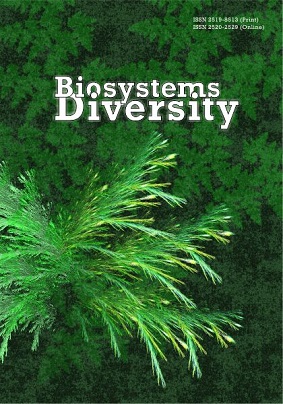Structure of litter macrofauna communities in poplar plantations in an urban ecosystem in Ukraine
Structure of litter macrofauna communities in poplar plantations in an urban ecosystem in Ukraine
Author(s): V. V. Brygadyrenko, O. Y. Pakhomov, E. V. Prokopenko, T. M. Kolombar, L. I. FalySubject(s): Sociobiology
Published by: Дніпропетровський національний університет імені Олеся Гончара
Keywords: forest ecosystems; biological diversity; litter invertebrates; dominance structure; trophic structure; size structure;
Summary/Abstract: The litter macrofauna of 8 plantations of Populus italica (Du Roi) Moench, P. deltoides Marsh. and P. alba L. was studied in the city of Dnipro. The invertebrates were taken by manual sifting of litter from experimental plots of 8 m2. The total number of litter macrofauna in the poplar plantations varied from 8 to 187 specimen/m2, on average 53 specimen/m2. The greatest variety of species was obtained from a white poplar plantation with common hop and an elm-poplar plantation with bare soil and Amorpha fruticosa L. bushes (15 and 9 species correspondingly). The maximum readings on the Shannon–Weaver diversity index come from the abovementioned areas (3.2 and 2.9 bits respectively). The highest number of zoophages (40%) was obtained from the white poplar plantation with common hop. There was great consistency in the species composition across the plots, with the same 60 species (more than 50% of the total number of species of litter macrofauna recorded in the study) being found in 7 out of the 8 study plots. The share of species rare for any given ecosystem exceeded 10% in only 2 out of the 8 plantations studied. The dominant group in the size structure of the litter macrofauna of the poplar plantations (44–96%) was invertebrates of 4–7 mm length. In 5 out of 8 poplar plantations no species over 15 mm in length were found. This indicates the degraded size structures of the litter macrofauna communities. In taxonomic structure the dominant groups were Formicidae, Pulmonata, Porcellionidae, Lygaeidae, Julidae, Silphidae, Araneae, Carabidae, Staphylinidae. The results obtained indicate the low variety and degradation of the trophic and size structure of the litter macrofauna of these urban poplar plantations, which are subject to lack of moisture.
Journal: Biosystems Diversity
- Issue Year: 25/2017
- Issue No: 1
- Page Range: 29-38
- Page Count: 10
- Language: English

